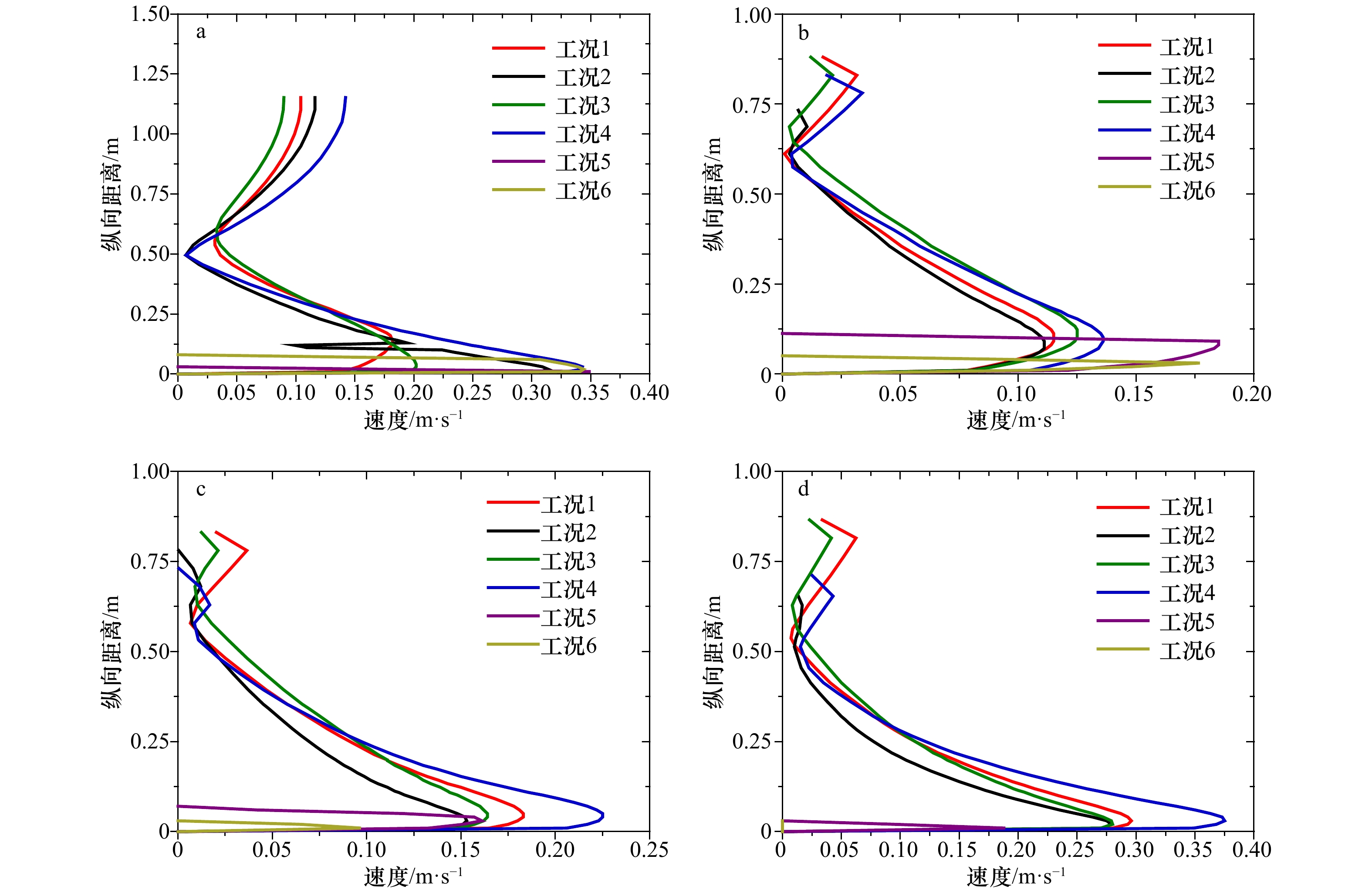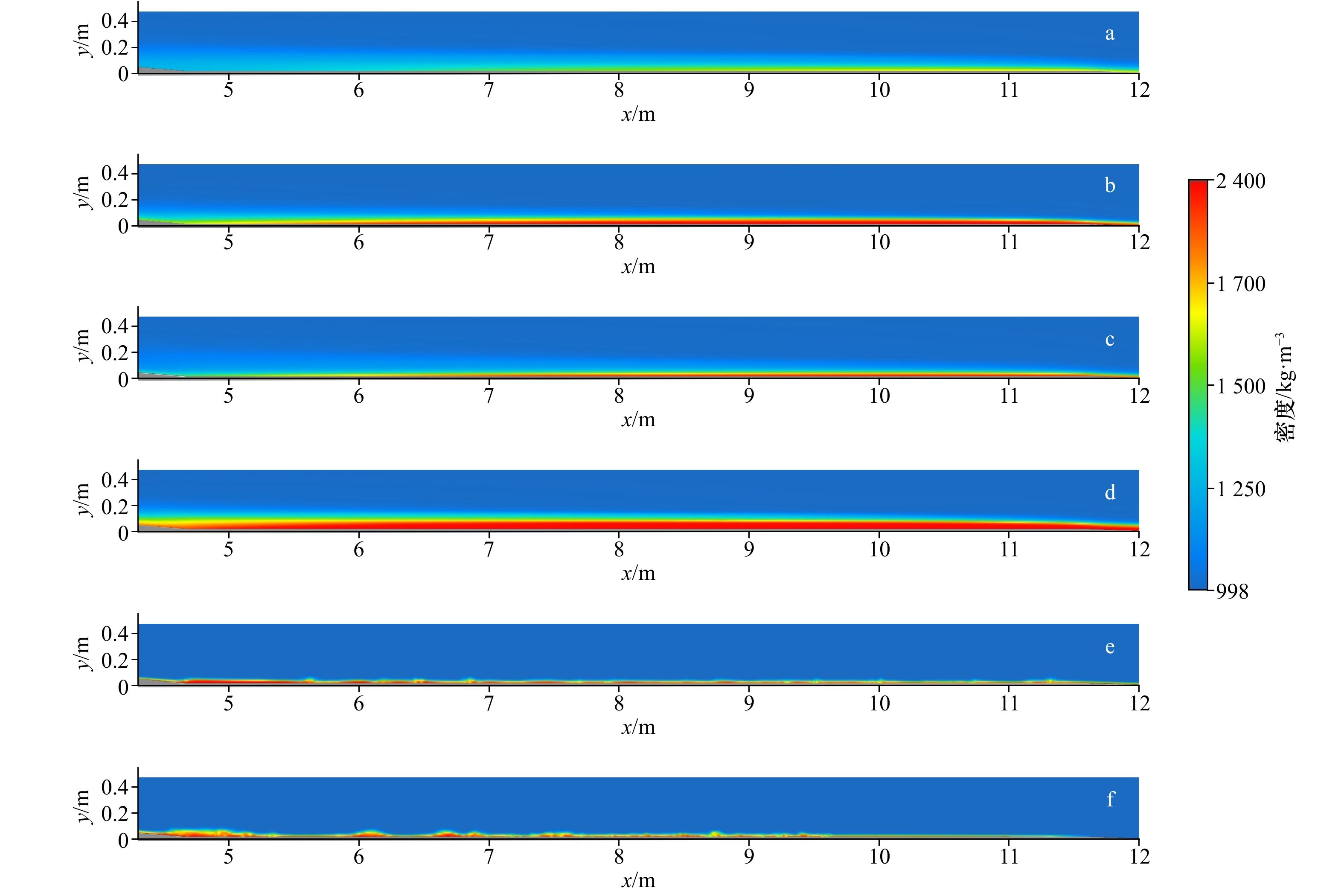Numerical simulation of turbidity current and sediment characteristics in submarine canyons
-
摘要: 数值模拟已成为研究海底浊流的重要方式,开展海底浊流的流动与沉积特征的数值模拟,对深水沉积体系特征研究、海底工程设施稳定性评价以及深海油气勘探均具有重要意义。本文基于不可压缩流体Navier-Stokes方程与湍流k-ε模型构建了浊流数值计算模型,设定不同粒径、速度与悬浮颗粒物浓度等初始条件,模拟并分析了单粒径悬浮颗粒驱动的持续入流的海底浊流沿海底连续坡折带的流动过程及沉积特征。模拟结果显示,浊流在斜坡段处于加速状态,水平段流速骤减并逐渐沉积,且浊流在小坡度的加速不改变浊流的沉积趋势。浊流由于环境水体的夹带效应逐渐增厚,且浊流头部形态与流动特征与实测资料吻合良好。本文另对多频次持续入流浊流进行了模拟,并将模拟结果与实测地层沉积特征对比,结果显示,多频次持续入流的海底浊流在纵向上可能会形成多个不连续鲍玛层序的叠积。Abstract: Numerical simulation has become an important way to research the turbidity current on the seabed. The numerical simulation of the current and sedimentary characteristics of the turbidity current on the seabed is significance to the deep water sedimentary system, the stability evaluation of seabed engineering and the deep-sea oil and gas resource exploration. A numerical model based on Navier-Stokes equation and the turbulence k-ε model for the simulation of turbidity current is applied to study the current and deposition of turbidity current with constant inflows into continuous slope breaks. Initial conditions such as different particle size, velocity and suspended particle volume fraction were set in the simulation. Simulated results show that the averaged velocity of the turbidity current accelerates at the slope, on the nearly horizontal bed, velocity drops obviously and gradually deposits at the horizontal bed. The acceleration of turbidity current at small slope does not affect the deposition trend. The thickness of the current gradually increases due to the environmental water entrainment, and the turbidity current head shape and flow characteristics are conformed favorably with the measured data. In addition, this paper also simulates the turbidity current of multi-frequency continuous inflow, and compares the simulation results with the measured sedimentary characteristics. The results show that the deposition of multi-frequency continuous inflow turbidity current may form the superposition of several discontinuous bauma sequences on the vertical strata.
-
Key words:
- turbidity current /
- sedimentation /
- mathematical model /
- slope break
-
图 6 浊流到达4.1 m处垂向速度剖面
第一个坡折带在模型5.1 m处;a. 不同的颗粒粒径条件下;b. 不同的入流速度条件下;c. 不同的颗粒浓度条件下
Fig. 6 Vertical velocity profiles at 4.1 m when turbidity current arrives
The first break in slope is at 5.1 m from the inlet; a. under different particle size in inlet condition; b. under different velocity in inlet condition; c. under different particle concentration in inlet condition
图 7 浊流到达6.1 m处垂向速度剖面
第一个坡折带在模型5.1 m处;a. 不同的颗粒粒径条件下;b. 不同的入流速度条件下;c. 不同的颗粒浓度条件下
Fig. 7 Vertical velocity profiles at 6.1 m when turbidity current arrives
The first break in slope is at 5.1 m from the inlet; a. under different particle size in inlet condition; b. under different velocity in inlet condition; c. under different particle concentration in inlet condition
图 8 浊流到达10.6 m处垂向速度剖面
第二个坡折带在模型11.6m处;a. 不同的颗粒粒径条件下;b. 不同的入流速度条件下;c. 不同的颗粒浓度条件下
Fig. 8 Vertical velocity profiles at 10.6 m when turbidity current arrives
The second break in slope is at 11.6 m from the inlet; a. under different particle size in inlet condition; b. under different velocity in inlet condition; c. under different particle concentration in inlet condition
图 9 浊流到达12.6 m处垂向速度剖面
第二个坡折带在模型11.6m处;a. 不同的颗粒粒径条件下;b. 不同的入流速度条件下;c. 不同的颗粒浓度条件下
Fig. 9 Vertical velocity profiles at 12.6 m when turbidity current arrives
The second break in slope is at 11.6 m from the inlet; a. under different particle size in inlet condition; b. under different velocity in inlet condition; c. under different particle concentration in inlet condition
图 10 200 s时浊流在各坡折带的速度剖面对比
a. 4.1 m处;b. 6.1 m处; c. 10.6 m处; d. 12.6 m处;第一个坡折带在模型5.1 m处,第二个坡折带在模型11.6 m处
Fig. 10 Comparsion of the velocity profiles around the slope break at 200 s
a−d corresponds to the the slope break in 4.1 m, 6.1 m, 10.6 m and 12.6 m; the first break in slope is at 5.1 m from the inlet, the second break in slope is at 11.6 m from the inlet
图 11 200 s时浊流悬浮颗粒在底床的体积浓度分布
a, b. 不同的颗粒粒径条件下;c. 不同的入流速度条件下;d. 不同的颗粒浓度条件下
Fig. 11 Distribution of volume fraction along the slope bottom of turbid suspended particles at 200 s
a, b. under different particle size in inlet condition; c. under different velocity in inlet condition; d. under different particle concentration in inlet condition
表 1 初始入流条件
Tab. 1 Numerical simulation initial conditions
工况 粒径/mm 颗粒物体积浓度/% 速度/m·s−1 工况1 0.005(黏土) 10 0.5 工况2 0.05(粉砂) 10 0.5 工况3 0.05(粉砂) 10 1.0 工况4 0.05(粉砂) 20 0.5 工况5 0.50(粗砂) 10 0.5 工况6 1 (粗砂) 10 0.5 -
[1] Middleton G V. Sediment deposition from turbidity currents[J]. Annual Review of Earth and Planetary Sciences, 1993, 21: 89−114. doi: 10.1146/annurev.ea.21.050193.000513 [2] 方爱民, 李继亮, 侯泉林. 浊流及相关重力流沉积研究综述[J]. 地质论评, 1998, 44(3): 270−280. doi: 10.3321/j.issn:0371-5736.1998.03.007Fang Aimin, Li Jiliang, Hou Quanlin. Sedimentation of turbidity currents and relative gravity flows: a review[J]. Geological Review, 1998, 44(3): 270−280. doi: 10.3321/j.issn:0371-5736.1998.03.007 [3] Garcia M, Parker G. Experiments on hydraulic jumps in turbidity currents near a canyon-fan transition[J]. Science, 1989, 245(4916): 393−396. doi: 10.1126/science.245.4916.393 [4] Gavey R, Carter L, Liu J T, et al. Frequent sediment density flows during 2006 to 2015, triggered by competing seismic and weather events: observations from subsea cable breaks off southern Taiwan[J]. Marine Geology, 2016, 384: 147−158. [5] Forel F A. Les ravins sous-lacustre des fleuves glaciaires[J]. Bulletin de la Société vaudoise des ingénieurs et des architectes, 1885, 101: 725−728. [6] Daly R A. Origin of submarine canyons[J]. American Journal of Science, 1936, 31(186): 401−420. [7] Kuenen P H. Experiments in connection with Daly's hypothesis on the formation of submarine canyons[J]. Leidse Geologische Mededelingen, 1937, 8(2): 327−351. [8] Bell H S. Studies for students: density currents as agents for transporting sediments[J]. The Journal of Geology, 1942, 50(5): 512−547. doi: 10.1086/625070 [9] 徐景平. 海底浊流研究百年回顾[J]. 中国海洋大学学报, 2014, 44(10): 98−105.Xu Jingping. Turbidity current research in the past century: an overview[J]. Periodical of Ocean University of China, 2014, 44(10): 98−105. [10] Inman D L, Nordstrom C E, Flick R E. Currents in submarine canyons: an air-sea-land interaction[J]. Annual Review of Fluid Mechanics, 1976, 8(1): 275−310. doi: 10.1146/annurev.fl.08.010176.001423 [11] Dengler A T, Wilde P, Noda E K, et al. Turbidity currents generated by Hurricane Iwa[J]. Geo-Marine Letters, 1984, 4(1): 5−11. doi: 10.1007/BF02237967 [12] Prior D B, Bornhold B D, Wiseman W J, et al. Turbidity current activity in a British Columbia Fjord[J]. Science, 1987, 237(4820): 1330−1333. doi: 10.1126/science.237.4820.1330 [13] Zeng Jianjun, Lowe D R, Prior D B, et al. Flow properties of turbidity currents in Bute Inlet, British Columbia[J]. Sedimentology, 1991, 38(6): 975−996. doi: 10.1111/j.1365-3091.1991.tb00367.x [14] 徐景平. 科学与技术并进——近20年来海底峡谷浊流观测的成就和挑战[J]. 地球科学进展, 2013, 28(5): 552−558. doi: 10.11867/j.issn.1001-8166.2013.05.0552Xu Jingping. Accomplishments and challenges in measuring turbidity currents in submarine canyons[J]. Advances in Earth Science, 2013, 28(5): 552−558. doi: 10.11867/j.issn.1001-8166.2013.05.0552 [15] Kuenen H, Migliorini C I. Turbidity currents as a cause of graded bedding[J]. The Journal of Geology, 1950, 58(2): 91−127. doi: 10.1086/625710 [16] Middleton G V. Experiments on density and turbidity currents: III. deposition of sediment[J]. Canadian Journal of Earth Sciences, 1967, 4(3): 475−505. doi: 10.1139/e67-025 [17] Garcia M H, Parker G. Experiments on the entrainment of sediment into suspension by a dense bottom current[J]. Journal of Geophysical Research, 1993, 98(C3): 4793−4807. doi: 10.1029/92JC02404 [18] Islam M A, Imran J. Vertical structure of continuous release saline and turbidity currents[J]. Journal of Geophysical Research: Oceans, 2010, 115(C8): C08025. [19] Britter R E, Simpson J E. Experiments on the dynamics of a gravity current head[J]. Journal of Fluid Mechanics, 1978, 88(2): 223−240. doi: 10.1017/S0022112078002074 [20] Huang Heqing, Chen Guang, Zhang Qianfeng. The distribution characteristics of pollutants released at different cross-sectional positions of a river[J]. Environmental Pollution, 2010, 158(5): 1327−1333. doi: 10.1016/j.envpol.2010.01.010 [21] Huang Heqing, Imran J, Pirmez C. Nondimensional parameters of depth-averaged gravity flow models[J]. Journal of Hydraulic Research, 2009, 47(4): 455−465. doi: 10.1080/00221686.2009.9522021 [22] Huang Heqing, Imran J, Pirmez C. The depositional characteristics of turbidity currents in submarine sinuous channels[J]. Marine Geology, 2012, 329−331: 93−102. doi: 10.1016/j.margeo.2012.08.003 [23] Huang H, Imran J, Pirmez C. Numerical modeling of poorly sorted depositional turbidity currents[J]. Journal of Geophysical Research: Oceans, 2007, 112(C1): C01014. [24] Huang Heqing, Imran J, Pirmez C. Numerical model of turbidity currents with a deforming bottom boundary[J]. Journal of Hydraulic Engineering, 2005, 131(4): 283−293. [25] Huang Heqing, Imran J, Pirmez C. Numerical study of turbidity currents with sudden-release and sustained-inflow mechanisms[J]. Journal of Hydraulic Engineering, 2008, 134(9): 1199−1209. doi: 10.1061/(ASCE)0733-9429(2008)134:9(1199) [26] Kassem A, Imran J. Three-dimensional modeling of density current. II. Flow in sinuous confined and uncontined channels[J]. Journal of Hydraulic Research, 2004, 42(6): 591−602. doi: 10.1080/00221686.2004.9628313 [27] Strauss M, Glinsky M E. Turbidity current flow over an erodible obstacle and phases of sediment wave generation[J]. Journal of Geophysical Research: Oceans, 2012, 117(C6): C06007. [28] Giorgio S F, Peakall J, Ingham D B, et al. A unifying computational fluid dynamics investigation on the river-like to river-reversed secondary circulation in submarine channel bends[J]. Journal of Geophysical Research: Oceans, 2011, 116(C6): C06012. [29] 姜涛, 解习农, 汤苏林. 浊流形成条件的水动力学模拟及其在储层预测方面的作用[J]. 地质科技情报, 2005, 24(2): 1−6. doi: 10.3969/j.issn.1000-7849.2005.02.001Jiang Tao, Xie Xinong, Tang Sulin, et al. Hydrodynamic simulation of turbidity and its application for reservoir prediction[J]. Geological Science and Technology Information, 2005, 24(2): 1−6. doi: 10.3969/j.issn.1000-7849.2005.02.001 [30] 姜涛, 解习农, 汤苏林, 等. 浊流成因海底沉积波形成机理及其数值模拟[J]. 科学通报, 2007, 52(16): 1945−1950. doi: 10.3321/j.issn:0023-074x.2007.16.017Jiang Tao, Xie Xinong, Tang Sulin, et al. Formation mechanism and numerical simulation of submarine sedimentary wave of turbidity current[J]. Chinese Science Bulletin, 2007, 52(16): 1945−1950. doi: 10.3321/j.issn:0023-074x.2007.16.017 [31] Jiang Tao, Zhang Yingzhao, Tang Sulin, et al. CFD simulation on the generation of turbidites in deepwater areas: a case study of turbidity current processes in Qiongdongnan Basin, northern South China Sea[J]. Acta Oceanologica Sinica, 2014, 33(12): 127−137. doi: 10.1007/s13131-014-0582-7 [32] Georgoulas A N, Angelidis P B, Panagiotidis T G, et al. 3D numerical modelling of turbidity currents[J]. Environmental Fluid Mechanics, 2010, 10(6): 603−635. doi: 10.1007/s10652-010-9182-z [33] 郭彦英, 黄河清. 海底浊流在坡道转换处的流动及沉积的数值模拟[J]. 沉积学报, 2013, 31(6): 994−1000.Guo Yanying, Huang Heqing. Numerical simulation of the flow and deposition of turbidity currents with different slope changes[J]. Acta Sedimentologica Sinica, 2013, 31(6): 994−1000. [34] Middleton G V. Submarine fans and channels[M]//Sedimentology. Encyclopedia of Earth Science. Berlin, Heidelberg: Springer, 1978. [35] Muck M T, Underwood M B, 高振中. 浊流爬坡流动的实地观察, 理论和实验模型的对比[J]. 地质科学译丛, 1991, 8(4): 66−70.Muck M, Underwood M B, Gao Zhenzhong. Upslope flow of turbidity currents: A comparison among field observations, theory, and laboratory models[J]. China Academic Journal Electronic Publishing House, 1991, 8(4): 66−70. [36] 姜辉. 浊流沉积的动力学机制与响应[J]. 石油与天然气地质, 2010, 31(4): 428−435. doi: 10.11743/ogg20100405Jiang Hui. Dynamical mechanism and depositional responses of turbidity current sedimentation[J]. Oil & Gas Geology, 2010, 31(4): 428−435. doi: 10.11743/ogg20100405 [37] 张一乙, 杨旸, 陈景东, 等. 悬沙组分对再悬浮过程响应的初步研究—以长江口南槽口门为例[J]. 海洋科学, 2016, 40(11): 129−137. doi: 10.11759/hykx20131212001Zhang Yiyi, Yang Yang, Chen Jingdong, et al. Preliminary study of the response of suspended sediment components to resuspension processes in the mouth of the South Channel, Changjiang River Estuary[J]. Marine Sciences, 2016, 40(11): 129−137. doi: 10.11759/hykx20131212001 [38] Azpiroz-Zabala M, Cartigny M J B, Talling P J, et al. Newly recognized turbidity current structure can explain prolonged flushing of submarine canyons[J]. Science Advances, 2017, 3(10): e1700200. doi: 10.1126/sciadv.1700200 [39] Ercilla G, Wynn R B, Alonso B, et al. Initiation and evolution of turbidity current sediment waves in the Magdalena turbidite system[J]. Marine Geology, 2002, 192(1/3): 153−169. [40] Hale R P, Nittrouer C A, Liu J T, et al. Effects of a major typhoon on sediment accumulation in Fangliao Submarine Canyon, SW Taiwan[J]. Marine Geology, 2012, 326−328: 116−130. doi: 10.1016/j.margeo.2012.07.008 -





 下载:
下载:
















